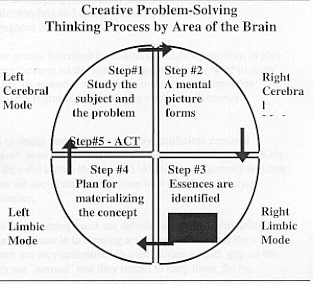| The Basis of Genius |
|
What IS Genius? Genius has a unique, essential foundation. Without it, a person cannot become a genius or have clear insights into the world in which he or she lives. Webster has six definitions for the word "genius". The first is "a guardian spirit assigned to a person at birth". The sixth definition, and the way we most commonly think of the term, has three parts. They are a) "great mental capacity and inventive ability; esp., great and original creative ability in some art, science, etc. b) a person having such capacity or ability c) popularly, any person with a very high intelligence quotient." High IQ is not the unique foundation of genius, although geniuses usually do have high IQs. It is how geniuses use their brain, which is quite different from the way "normal" people use them that is critical. We all know people who consistently come up with insights, ideas, and solutions that surprise us. People say, "She's brilliant, or I don't know how he does that." We recognize that, somehow, they are doing something different. Sometimes such people inspire awe or admiration; other times, they engender fear and resentment. But what are these people doing with their brain that's different? We looked for something consistent and constant among people recognized by society, and their respective fields, as geniuses or original thinkers. We found it. The following quotes reveal what we found. Can you see the repeating pattern common to all of them?
— Charles Darwin, The Origin of Species
— William James, Principles of Psychology
—Albert Einstein, Autobiographical Notes
—Frank Lloyd Wright, quoted in Jonathan Hale, The Old Way of Seeing
—Carl Jung, Modern Man in Search of a Soul
—R. Buckminster Fuller, Critical Path
—Stephen Hawking, A Brief History of Time "Remember, this isn't memorization. This is learning. When you memorize something, you don't adjust to subtle changes very quickly. When you learn it — when you know how and why something is being done, and not just what — you can react quickly to different fronts and coverages." —Joe Montana, Art and Magic of Quarterbacking Here's Joseph Meeker's explanation of what's going on, as he described it in Wisdom and Wilderness:
Meeker calls it "wisdom". It really has several names more indicative of its true nature: systems thinking, holistic thinking, creative thinking, whole-brain thinking, and integrative thinking. We prefer the term "integrative thinking". What IS "Integrative Thinking"? Integrative thinking is what many people know as "the creative process". Here's how it works. Different parts of the brain contribute different critical elements of insight, revelation and deep understanding. This is easy to illustrate using a four-quadrant model of the brain that accounts for its functions. First, look at the general model of brain function.
1. Collects information about the subject and studies it. This is predominantly analytical, left-brain activity. 2. Assembles that information into a complete mental picture of the subject. This is right-brain activity. 3. Finds, in that picture, the essence of the subject. This may result in an idea or image of something to be done - our traditional definition of "Creativity". But it may also result in deep understanding or comprehension of the essential nature of the subject being studied, the "Aha!" experience. 4. Creates a plan for doing something to communicate and materialize the idea, concept or understanding. 5. Takes action on that plan.
Both integrative thinkers and "normal" people use the sequential, analytical abilities of their left-brain to gather information about something. But geniuses and systems thinkers use the "synthetical" abilities of their right brain to integrate the information into complete pictures that show the relationship between the pieces of data. This reveals what the information actually means. That's the source of their insight, deep understanding, and unique comprehension. Normal people don't create these pictures. They typically use data quantitatively, to measure things, not qualitatively, to understand their nature. Among the more distinguishing traits of integrative thinking is that the pictures it creates shows all the pieces of the system and the nature of their relationship to each other independently of time and space. It recognizes the "spiritual" portion of reality- the intangible causes of tangible effects. Our social systems, by their nature, work to prevent genius. They actively prohibit creative, holistic, integrative thinking. Our education system leads the prohibition. To understand what's going on, we have to understand a bit about systems. Some Basics of Systems The Structure of Systems We have representations of systems in science, religions, cultures, the arts, architecture, and design. They are all the same - concentric shapes emanating outward from a nucleus. Concentric circles or ellipses are perhaps the most common, like "a stone thrown into a pond".
Here's one example. We've researched business propositions for over twenty-five years. We've found that every business-to-business transaction is based on profitability. In other words, companies only buy things they believe will either increase sales or reduce operating costs. The root cause of this universal condition is that the vast majority of people in business, especially top management, believe the purpose of business is "to make money". For the same reason, companies can justify not doing anything that doesn't increase sales or reduce operating costs, or actually increases operating costs, like installing the systems necessary to prevent environmental pollution. This illustrates the power of a system's purpose. Open and Closed Systems The most essential difference between open and closed systems in human society lies in how they define their purpose. Every system is, at its core, a transaction between two principal partners. Figuring out the two principal partners in human social systems is pretty straightforward. In personal relationships, it's the two people. In education, it's the provider of the information and those who use it. Typically, that's the teacher and the students. In business, the two principal partners are the producer of the product or service and its user. In healthcare, it's the doctor and the patient.
The Lifecycle of Systems Social systems have two demonstrated phases - the formative and the normative. A potential third phase is the integrative. The Formative Phase All social systems originate in an intangible or "spiritual" state as a purpose, a concept, an idea, a philosophy, and a solution to a problem in someone's mind. That purpose may be either open or closed. In business, for example, the purpose of a new business concept might be open. It would recognize that the new product or service is being deliberately created to provide some unique usefulness to some intended group of beneficiaries (a "market"). It could also be closed. It could view the new product or service only as a new way "to make money". Once the concept or originating principle is defined, people move to manifest it - to give it material forms and processes that accomplish its purpose. We call the system's material state "reality", even though it's only the material portion of reality, because our physical senses - sight, hearing, touch, taste, smell - can detect it and because Descartes told us that "only matter matters". However, whether the intended system's purpose is open or closed, the work in this phase is highly creative. It's mostly problem solving; trying to create something that has not previously existed. In this phase, the key questions are, "What are we trying to do, and why?". People focus on outcomes. The formative phase is about "making it up as you go along". Decision-making criteria are highly qualitative. Very few professions offer continuous opportunity to work this way. The arts, architecture, industrial design and the development of new technologies, products and services often do. The arts probably attract the highest percentage of integrative, holistic thinkers. The Normative Phase The normative phase of all systems has the same purpose, which is completely independent from the originating purpose of any specific system. The goal of the formative phase was to figure out how to materialize the system's originating intent. The goal of the normative phase is to maximize the efficiency of the forms and processes it created to do that, whatever they were. A normative system is built for repetition - doing the same things the same way, under the same conditions, day after day. To do this, it discards the system's specific originating purpose, the reason it exists in the first place. Whether the system's originating purpose was open or closed, it now becomes closed. People in the system lose sight of its original purpose, or, more likely, the people who understood the purpose leave the system. New people come into it. "The plane is flying; our job is to keep it in the air." The destination no longer matters. "Just fly higher and faster." To maximize efficiency and predictability, people now pursue conformity to established "norms" of form and process. They seek to eliminate diversity and variance. Thus, normative systems overtly punish creativity, because creativity produces variance and decreases predictability. The normative phase is about control and conformity. Its dominant criteria are quantitative. As the system increases in size, its functions become more developed. They specialize. Nature also specializes, but doesn't normalize. Natural living things, that is, all species except man, are open, adaptive systems. They go directly from their formative phase to an integrative phase. They change their operating subsystems in accord with their primary purpose. When whatever they're doing doesn't work anymore, they do something different - based on purpose, not process. Thus, their subsystems evolve interdependently because doing so is critical to the larger system's chances of survival. Non-human systems show us that diversity, variance and creative adaptation directly correlate to survival, health and prosperity. As Darwin pointed out nearly 150 years ago:
Yet we humans continue to create and manage our systems to eliminate the very factors that make them vital. Our specialization takes a very different form. Subsystems and components specialize independently. People concentrate on refining and standardizing the forms and processes of their function. People focus more and more on pieces rather than wholes. The "big picture" gets progressively fragmented. This is bureaucracy - attention to form and process, oblivious to cause, the "why" behind the action. As we imagine that we can control our environment, we also ignore it. We get "monkey see, monkey do", or unexamined imitation. Socrates referred to the normative existence as, "An unexamined life [that] isn't worth living". Obsessed with control, we begin to see both our principal partners in the exchange for mutual benefit - customers, students, patients - and people within our own system who "vary" from the norms, as enemies, not assets for survival. Philosophers call this "dualism", light against dark, good against evil. Dualism gives normative systems their "either-or", "win-lose" character. "Either you're with us or against us." Because "normal" people focus on form and process, they say, "Either you look like us, you act like us, you do what we do, or you don't. If you do, you're in. If you don't, you're out." When the system's objective is to increase predictability, that is, consistency of repeatability, deviance and diversity are "out". Therefore, talented, creative, original thinkers are also "out". They refuse to "check their brain at the door", to mindlessly abide by unexamined assumptions. Organizations, whether companies, school districts or government agencies, actively push them out the door until no one is left to ask, "Why are we doing this in the first place? And is what we're doing really working?" Normative systems, intent on perpetuating the status quo, actively persecute everything required for "genius". William James and John Dewey challenged this dualistic approach to human organization at least 100 years ago, contending that all functions of the mind are inextricably tied to interactions with the environment, or context and that such continuing interaction, examination of purpose and goal, is the only determinant of "truth", or validity. "Does it work?", they asked. But we're still not paying attention; norms are powerful and deadly. The (potential) Integrative Phase This is the vaunted "transformation" we hear so much about, from everybody from New Age gurus to organizational development consultants. As far as we know, no organization or social institution has accomplished it, only a few individual people. Some are recognized as geniuses; the others opt out of our social systems, becoming hermits, house painters, self-employed consultants, and bait shop owners. Hermann Hesse wrote of this "struggle between rule and spirit" in the educational system:
If you understand the formative and normative phases of a system, the integrative phase is relatively easy to understand. Conceptually, put the formative and normative together; integrate the system's original intent with the forms and processes for accomplishing it. The integrative phase unifies the fragments of the normative by recognizing the system's original, open intent or purpose. It doesn't mean throwing away what exists. It means discovering why it exists and then redesigning the system, based on current conditions, to accomplish that original intent. One of the primary reasons most attempts at reform fail is that the reformers challenge the existing system "normatively" rather than "systemically". They challenge what it does, but not why. They don't recognize that the system's operating purpose is the root cause of its dysfunction. And that it is invariably a closed system purpose. For example, 95% of the attempts to create a new business fail. The root cause of this is the belief that the purpose of business is "to make money". Truly transforming from a normative to an integrative system lies in recognizing the system's original open, integrative purpose - providing some unique benefit to a principal external partner. Further, it must recognize that the partnership is interdependent. The partner is not an "other" to be controlled, but respected on an eye-to-eye basis. People in integrative systems know the basis of unity between the principal partners, even after the system has become large and materially complex. Therefore, they can see the meaning behind its forms and processes. They can see the relationship between causes and effects. They know why things do or don't make sense. They know what to change and when to change it. Unlike a normative system, whose complexity is incomprehensible, people can comfortably function in the complexity of an integrative system because they have the foundation of mutually beneficial purpose for organizing all the details. Our Educational System The root problem of our educational system lies in its belief of its purpose; a closed system purpose of ever there was one. Two people who have studied our educational system extensively are Dr. E. Paul Torrance of the Georgia Center for Creativity and Howard Gardner of Harvard's "Project Zero". Both have written several books about it. They provide us with plenty of evidence of just how closed and normalized it is. In Why Fly?, Dr. Torrance wrote:
This is classic "normative". The more a teacher knows about the subject he or she teaches, and the more creatively that knowledge is transferred to students, the lower that teacher's standing in his or her community. Why? Because this teacher is the greatest threat to the system's existing forms and processes, which signify efficiency and predictability. In The Unschooled Mind, Howard Gardner described the nature of education essentially the same way:
There's no doubt that the US educational system not only is "normative", but has been from its inception Russell Nye, in The Cultural Life of the New Nation, in a chapter aptly titled "The Training of Free Minds" (emphasis ours), tells us that the aim of 17th century education was:
It's easy to see where this came from - Christianity's concept of "Original Sin" - probably the most effective normative concept for controlling people ever invented. So much for the separation of church and state when education's normative, operating purpose is derived from the church's normative, operating purpose. Clearly, this statement of purpose is about "fixing" innately "broken" people. Children are not seen as partners, with whom adults might exchange mutual benefit, but as "subjects" to be controlled, shaped, standardized, and normalized. The transition from colonies to a new nation reinforced dedication to this purpose. All minds and eyes were focused on a new form and structure of government. Would it, could it, succeed? Heroes today, our founding fathers were, frankly, a little nervous about whether or not what they had theorized so eloquently was really going to work. Particularly, they worried about what was going to happen with many more people actively participating in governmental decisions than ever before and how to assure that such participation would produce good government. So, the purpose of widespread education, from our government's point of view, became, as Nye puts it, "to train citizens for their civic, social, and intellectual responsibilities." Toss in the developing interest in practical, utilitarian science, symbolized then as now by Benjamin Franklin's activity with keys, kites, and lightning. Mix it up with the old British aristocratic tradition of producing the "scholar-gentleman". What we have is an educational system with the purpose of shaping undisciplined, ignorant, "immoral" children into well-mannered, socially acceptable, normal adults. Nowhere in sight is anything about supporting the child's best interests, about developing his or her capacity to think, to creatively solve problems, to actualize his or her potential for genius. Education System Prevents Integrative Thinking Thinking How does our educational system inhibit student's ability to develop deep understanding and knowledge of the subjects they study? It's by transmitting subject matter linearly, to their "left-brain" only. By strongly discouraging creative thinking, there it stays, never transformed into the "right-brain" pictures that give it meaning to the students. The drive to create "normal" people severely inhibits perception and comprehension by persecuting creativity and original, holistic, integrative thinking. The goal to enforce conformity to "norms" reinforces people's analytical, linear, left-brain processing - their ability to retain, organize and plan to these rules and regulations. Simultaneously, persecution of creative problem solving diminishes comprehension, insight and deep understanding. In effect, our educational system conditions students to be able to "do" and to not be able to "see". It literally "dumb students down" by so strongly influencing how they are allowed to use their brains. Here's a picture of it:
This perception of how schools condition people to use only their left-brains also explains a phenomenon Howard Gardner reported in The Unschooled Mind. He stated that children already have ideas about how the world works when they enter school.
Initially he explained:
Gardner refers to the conclusions pre-schoolers make about how the world works as "primitives". Then he reports how tenaciously these primitives remain. Children will appear to be "doing well" in school, getting passing or even high grades by reporting back the correct answers. However, after they leave school, they often revert to their initial "primitive" conceptions of how the world works. In the following particular excerpt he focuses on an example from the study of science, but the phenomenon is generalized and by no means limited to science:
The essential reason for this becomes apparent when we understand the difference between how "primitive" conclusions are formed and information, conflicting or not, is received and stored by students in school. The young child invents - discovers - his or her primitive conclusions. This requires "whole-brain" activity - integrative thinking. Left to his or her own natural inclinations, the child also uses synthetical right-brain capabilities, his or her genius capacity, to create meaningful pictures from the information he or she has gathered via left-brain work, even though its typically incomplete and/or inaccurate. This not only reveals how the pieces of information fit together, holistically; it also reveals a central organizing principle, and, therefore, gives the information specific meaning. In contrast, the information imparted by the teacher, in a traditional class setting, only goes as far as the information gathering portion of the process. The student is not given the opportunity to "own" it, to discover, internalize and give it personal meaning. Gardner is correct when he says, "Never overtly examined, never brought into direct confrontation with [laws of physics] that turn out to be invalid or limit them in various contexts, these principles emerge spontaneously as soon as a new problem comes across the horizon". More specifically, information obtained in the traditional classroom setting is never brought into direct confrontation with the pictorial conceptions the young child formed because it is never synthesized, in the child's right-brain, into a system that reveals equally powerful meaning and could, therefore, displace the previous, more limited or inaccurate version. Now we know precisely why so many of "the best and the brightest" announce that "school is boring", that it has nothing to offer them. They struggle and argue with the standardized tests designed to find out whether or not their left-brains have properly absorbed the data. They see bigger pictures than the information given in the questions allows. They look at the multiple choice answers provided and say to themselves, "But none of these are really right." Eventually, many of them drop out, wandering off to educate themselves as best they can. Fixing Our Educational System Developing the ability of our educational system to develop students' abilities to think, to comprehend, means going from this:
to this:
In a nutshell, we need to support and develop student's ability to genuinely solve the new problems they face as their environment continues to change. In other words, we need to develop people who can think integratively, as open systems themselves, before we can ever hope to achieve open, integrative social systems. Dr. Torrance has known this for decades. As far back as 1899, John Dewey wrote School and Society, positing that children need to actively participate in their education by interacting with their environment and solving problems for themselves. He founded and directed a laboratory school at the University of Chicago, demonstrating that his idea worked. Dewey defined an "open purpose" for Education. But he didn't recognize the closed, normative one that was so firmly entrenched or the power it had to perpetuate itself. He just thought our educational process wasn't working very well. Few of education's more recent critics have thought one way or the other about the core purpose of the system because, until now, a basic understanding of how systems work really hasn't been applied to the question. We've had a lot of clear evidence that the system isn't working very well, much defining of what's wrong, but, as Hawking and Montana noted, not enough asking why from a fundamental perspective of systems. Actually effecting substantive change in our Educational system begins with its purpose. Its purpose must change from closed, "normative" to open, "integrative". This means a definition of purpose that focuses on the best interests of Education's "external partner", the potential beneficiary of education, and the student. Which statement of purpose is more beneficial to students, individually - and collectively, to our future as a society? 1. The Current, Normative Purpose of Education: The purpose of Education is to condition students to behave according to traditional social norms. 2. The Potential, Integrative Purpose of Education
By "think" we mean the whole, integrative capacity for genius described by Einstein, which, by the way, is also the definition Dr. Torrance uses. He, and several other educators on the leading edge, also knows what to do to materialize the integrative purpose of education - change its essential nature from linear data transmission coupled with active punishment of creativity to a discovery regimen that promotes the student's creative problem solving abilities. At minimum, the discovery regimen permits students to create new answers that have sufficient personal meaning, and therefore, power, to replace the "primitive", semi-functional answers they brought to school. Kids would actually know more after they left school than they did before they started. At best, the discovery regimen develops every child's potential for genius and changes the social status of anyone who thinks creatively, holistically, and integratively, from exile to valued member. Of course, there is that unsettling aspect of unpredictability - letting go of the delusions that we are a) doing the right thing now, and b) in control of it. This is the primary obstacle to creating a new system because the very "normal" people now in control of our education system are very committed to maintaining a death grip on the status quo. They have their jobs precisely because they are "normal" and they intend to keep them. So far, they've been fairly successful in thwarting both progressive education and open schools, two attempts to change education into an integrative system focused on the student's best interests. That strongly suggests we will have to create an alternative system to which members of our society will gravitate as they recognize its unique value. In fact, an alternative system is already developing. Many parents intuitively recognize that the mainstream system isn't working. They are behaving like participants in a natural system, not as humans constrained by artificial norms. Increasing numbers of them are enrolling their children in schools not in the public educational system, such as those based on the principles of Maria Montessori. Dr. Montessori sees children as naturally inclined to learn, as "born free", not as wild things that must be molded into sociability:
Waldorf Schools focus almost exclusively on "right brain" development in the early years, generally not even introducing the basic linear activity of reading until a child is 7 years old. Then there is the charter school movement, an ingenious program created by a small group of seemingly mainstream educators in Minnesota's Twin Cities. The barrier to creating schools for large numbers of children around an open, integrative purpose has been the fact that the normative system had all the money. Alternative ventures required significant financial commitment from parents. Charter school laws enable public funding for schools designed and managed by independent groups of parents and educators. They are still under the general aegis of the public system, but they are allowed to define their own purposes and methods for achieving them. Over 1,000 charter schools have opened across the country since the first legislation was adopted in Minnesota barely 10 years ago. Like any normative system intent on perpetuating itself, mainstream education is showing clear signs of attempting to nit-pick charter schools out of existence, with everything from intense scrutiny of budgets and accounting practices to inconvenient or non-existent bus service for charter students. William James and his disciple, John Dewey, both heavily influenced by Charles Darwin, were very right when they concluded that people are not exempt from the systems of nature. Nor are our minds, thoughts, concepts, and ideals separate from the environment and context of which we are an inherent part. The systems we create are tested no differently from other evolutionary developments: do they work? Those that cease to work because they have ossified into mindless, normative repetition can only fall by the evolutionary wayside in their current state. Alternatively, they can transform in fully functional integrative systems - and prosper. This article is based on Cliff Havener's new book, Meaning - The Secret of Being Alive. By looking at our "human condition" in the context of General Systems, it provides the essential explanation of why so many things don't work, are meaningless and why "common sense" is so uncommon. It also shows what we can do to solve this problem. If you'd like to know more about this book, visit its website - http://www.forseekers.com. There, you can get an overview, check out reader reviews, even download its Introduction and first three chapters.
|
©1998-2007,
International Network on Personal Meaning, Unless otherwise noted
Visit http://www.meaning.ca
for more information.

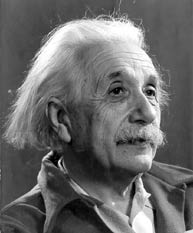
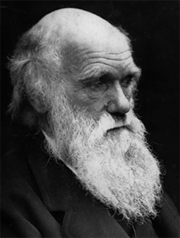 "It
is interesting to contemplate a tangled bank, clothed with many
plants of many kinds, with birds singing on the bushes, with various
insects flitting about, and with worms crawling through the damp
earth, and to reflect that these elaborately constructed forms,
so different from each other, and dependent upon each other in
so complex a manner, have all been produced by laws acting around
us....There is grandeur in this view of life."
"It
is interesting to contemplate a tangled bank, clothed with many
plants of many kinds, with birds singing on the bushes, with various
insects flitting about, and with worms crawling through the damp
earth, and to reflect that these elaborately constructed forms,
so different from each other, and dependent upon each other in
so complex a manner, have all been produced by laws acting around
us....There is grandeur in this view of life."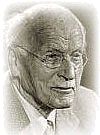 "If
we are still caught by the old idea of an antithesis between mind
and matter, the present state of affairs means an unbearable contradiction;
it may even divide us against ourselves. But if we can reconcile
ourselves with the mysterious truth that spirit is the living
body seen from within, and the body the outer manifestation of
the living spirit - the two really being one -- then we can understand
why it is that the attempt to transcend the present level of consciousness
must give its due to the body. We shall also see that belief in
the body cannot tolerate an outlook that denies the body in the
name of the spirit."
"If
we are still caught by the old idea of an antithesis between mind
and matter, the present state of affairs means an unbearable contradiction;
it may even divide us against ourselves. But if we can reconcile
ourselves with the mysterious truth that spirit is the living
body seen from within, and the body the outer manifestation of
the living spirit - the two really being one -- then we can understand
why it is that the attempt to transcend the present level of consciousness
must give its due to the body. We shall also see that belief in
the body cannot tolerate an outlook that denies the body in the
name of the spirit." However,
if we do discover a complete theory, it should be in time understandable
in broad principle by everyone, not just a few scientists. Then
we shall all, philosophers, scientists, and just ordinary people,
are able to take part in the discussion of the question of why
it is that we and the universe exist. If we find the answer to
that, it would be the ultimate triumph of human reason —
for then we would know the mind of God."
However,
if we do discover a complete theory, it should be in time understandable
in broad principle by everyone, not just a few scientists. Then
we shall all, philosophers, scientists, and just ordinary people,
are able to take part in the discussion of the question of why
it is that we and the universe exist. If we find the answer to
that, it would be the ultimate triumph of human reason —
for then we would know the mind of God." Now
look at the creative process. It's initiated because a person develops
interest in a subject, problem or riddle. Then the person:
Now
look at the creative process. It's initiated because a person develops
interest in a subject, problem or riddle. Then the person: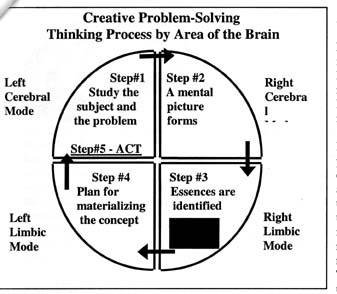 Einstein's
vision of the Theory of Relativity is a classic example of this
type of thinking. It happens to be the one for which he gained recognition.
But he had thousands of others. His deep understanding of "thinking",
illustrated previously, is another example.
Einstein's
vision of the Theory of Relativity is a classic example of this
type of thinking. It happens to be the one for which he gained recognition.
But he had thousands of others. His deep understanding of "thinking",
illustrated previously, is another example. 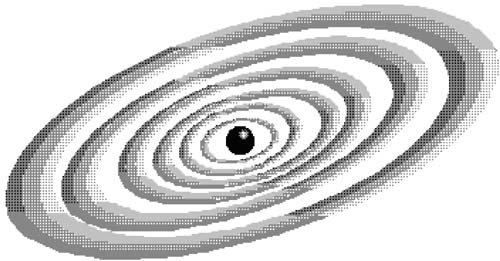 In
human social systems, the nucleus, or central organizing principle,
is the system's purpose. It defines the system's nature. In fact,
purpose is such a powerful determinant of the system's essential
nature, it could be considered "omnipotent".
In
human social systems, the nucleus, or central organizing principle,
is the system's purpose. It defines the system's nature. In fact,
purpose is such a powerful determinant of the system's essential
nature, it could be considered "omnipotent". 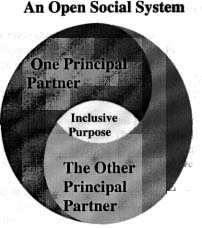 The
critical question is "For what purpose does this transaction
occur? Everything else in the system is defined by the answer
to this question. In an open system, the critical partners are
aware of their interdependence and any statement of purpose is inclusive;
that is, it recognizes benefit to both. In a closed system,
the partners do not recognize their interdependence. Statement of
purpose by one is exclusive of the other. Each recognizes only what
he or she wants, ignoring the reciprocity between them.
The
critical question is "For what purpose does this transaction
occur? Everything else in the system is defined by the answer
to this question. In an open system, the critical partners are
aware of their interdependence and any statement of purpose is inclusive;
that is, it recognizes benefit to both. In a closed system,
the partners do not recognize their interdependence. Statement of
purpose by one is exclusive of the other. Each recognizes only what
he or she wants, ignoring the reciprocity between them. 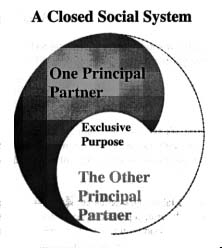 A
statement of an open purpose for business, for example, would be
"the purpose of business is to exchange usefulness for mutual benefit."
The producer provides usefulness in the form of a product or service.
The user, in a monetary system, reciprocates with money - a promissory
note of "usefulness". In a barter system, the two principal partners
exchange usefulness in the form of products or services. It should
be immediately apparent that the statement of purpose currently
used by producers as the purpose of business - "to make money" -
assumes a closed system that the seller controls. We'll see a precisely
parallel condition in education.
A
statement of an open purpose for business, for example, would be
"the purpose of business is to exchange usefulness for mutual benefit."
The producer provides usefulness in the form of a product or service.
The user, in a monetary system, reciprocates with money - a promissory
note of "usefulness". In a barter system, the two principal partners
exchange usefulness in the form of products or services. It should
be immediately apparent that the statement of purpose currently
used by producers as the purpose of business - "to make money" -
assumes a closed system that the seller controls. We'll see a precisely
parallel condition in education.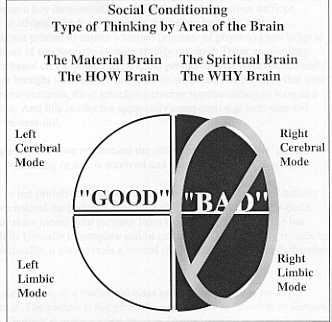 By
the time most students become adults, they have been thoroughly
conditioned out of their ability to think integratively. Geniuses
and other holistic thinkers are the ones who have "escaped" our
educational system.
By
the time most students become adults, they have been thoroughly
conditioned out of their ability to think integratively. Geniuses
and other holistic thinkers are the ones who have "escaped" our
educational system. 
